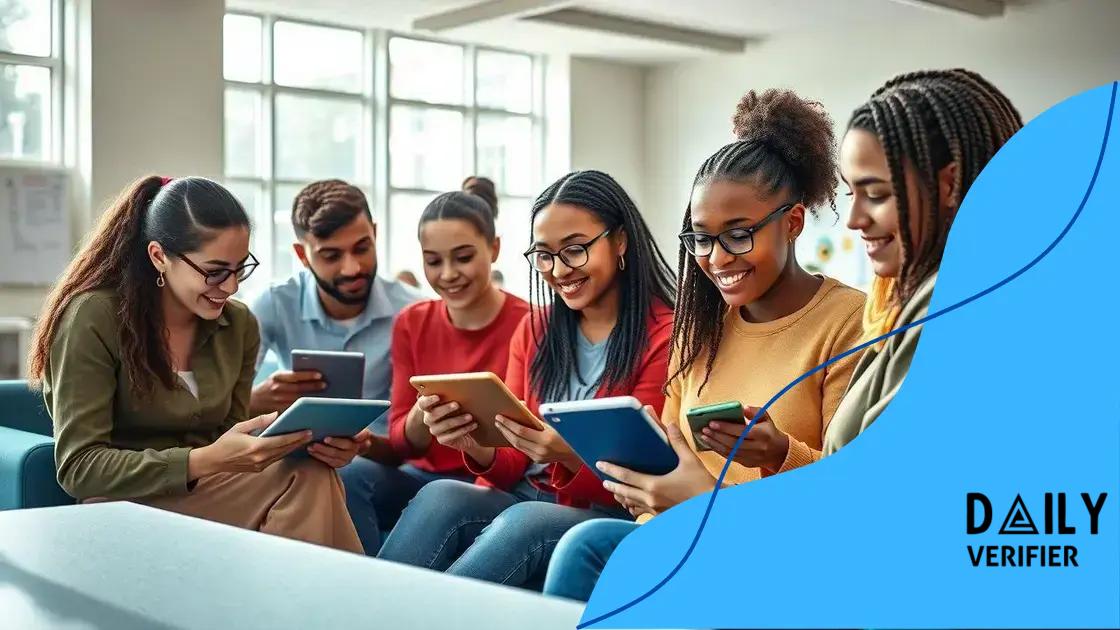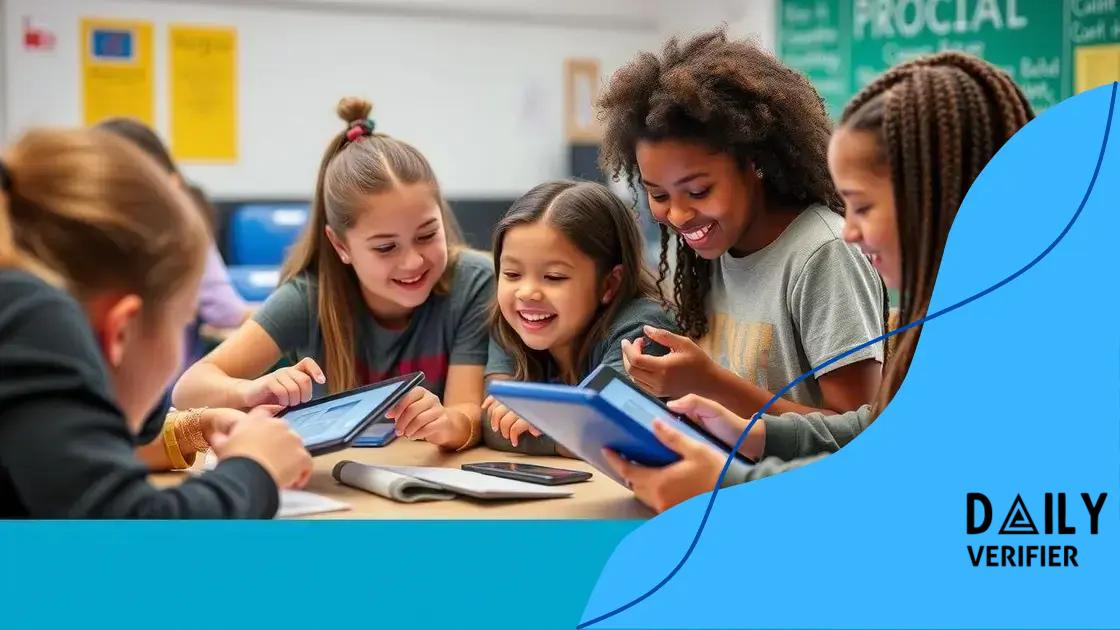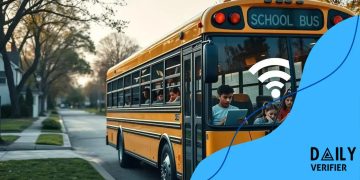Free tablets given to students: a game changer for education

Free tablets given to students enhance learning by providing access to interactive resources, improving engagement, and fostering independence and confidence, leading to significant academic success.
Free tablets given to students are becoming a pivotal tool in modern education. Imagine how these devices can enhance learning and bridge gaps that once seemed insurmountable. Ready to discover how this initiative can change lives?
The impact of technology in education
Technology is reshaping education in remarkable ways. It creates exciting opportunities to enhance learning and accessibility for students everywhere. As we explore these advancements, it’s important to consider how technology influences classroom environments and student engagement.
Interactive Learning Experience
With the rise of free tablets, students can access a wealth of information at their fingertips. These devices offer interactive tools that can make lessons more engaging. Teachers can introduce apps that help with everything from math to reading skills.
- Increased student participation
- Access to diverse resources
- Personalized learning paths
Furthermore, technology fosters a collaborative environment. Students can easily communicate with each other, share ideas, and work on group projects. This teamwork can enhance their understanding of subjects, making learning a shared adventure.
Bridging the Digital Divide
One of the primary goals of providing free tablets is to bridge the digital divide. Many students come from backgrounds without easy access to technology. By providing these devices, schools ensure that every student has the chance to succeed. Schools are not just handing out tablets; they are giving students the tools to thrive in a digital world. This initiative helps level the playing field, enabling students from various socio-economic backgrounds to engage equally in their education.
The availability of online resources also supports different learning styles. Visual learners benefit from videos, while auditory learners may prefer podcasts. This variety allows educators to reach all students more effectively, ensuring that no one falls behind.
Why are schools providing free tablets?
Many schools are now providing free tablets to students, and this shift is transforming how education is accessed. The primary reason for this initiative is to ensure that all students have equal access to the resources they need to succeed.
Enhancing Learning Opportunities
Offering tablets can enhance learning opportunities in numerous ways. These devices allow students to tap into a vast pool of digital resources. They can explore online libraries, educational apps, and interactive content that traditional methods cannot provide.
- Access to personalized learning tools
- Engagement through multimedia content
- Facilitation of remote learning opportunities
Furthermore, tablets can support different learning styles. For example, visual learners can benefit from videos, while auditory learners can use podcasts. This inclusivity ensures that education reaches every student.
Bridging Educational Gaps
The gap between students with access to technology and those without can be significant. By providing free tablets, schools aim to bridge this gap. It levels the playing field and gives every student an equal chance to participate in modern learning.
In today’s digital age, technology plays a crucial role in education. Schools recognize the importance of preparing students for a world that increasingly relies on technology. Therefore, they are making efforts to integrate these devices more fully into the curriculum.
How tablets enhance student learning experiences

Tablets are powerful tools that can significantly enhance student learning experiences. These devices provide a range of features that engage students and support their educational needs. By using tablets, students can access various forms of content, which makes learning more interactive and enjoyable.
Interactive Learning Tools
Tablets allow students to use interactive learning apps that cater to different subjects. These apps can offer quizzes, games, and virtual simulations which make learning fun. When students interact with the material, they are more likely to retain the information and stay motivated to learn.
- Hands-on simulations for science lessons
- Language learning apps with speaking exercises
- Mathematics games that challenge critical thinking
Additionally, tablets offer access to videos and tutorials that can clarify complex topics. For instance, a student struggling with a math problem can watch a tutorial that breaks down the solution step-by-step. This on-demand learning enables students to learn at their own pace.
Collaboration and Communication
Another advantage of using tablets is that they foster collaboration among students. When working on group projects, they can easily share documents and ideas through various apps. This type of collaboration encourages teamwork and helps develop essential communication skills.
Moreover, tablets can connect students and teachers through online discussion platforms. This connection allows students to ask questions and get immediate feedback, aiding their understanding. Technology can narrow the gap between students and educators, making education more accessible and supportive.
Challenges faced with tablet distribution
Distributing tablets to students can come with various challenges that schools must address. These challenges can impact the effectiveness of the initiative and the overall experience of the students.
Logistical Issues
One major challenge is the logistics of distributing the tablets. Schools must ensure that every student receives their device in a timely manner. This includes organizing the pickup or delivery process, which can become complicated.
- Tracking inventory to prevent shortages
- Scheduling distribution events
- Training staff to assist with the distribution
Additionally, some students may face issues if they are absent on the distribution day. Schools need to find ways to accommodate these students so that no one is left without a tablet.
Technical Support and Maintenance
Another significant challenge is providing ongoing technical support. Students may encounter issues with their tablets, from software glitches to physical damage. Schools need a plan to address these problems swiftly to minimize disruptions in learning.
Setting up a robust technical support system is essential. Educators and IT staff should be trained to help students troubleshoot common issues. This assistance can empower students to use technology confidently, but it requires proper resources and time investment.
Moreover, keeping the devices updated with the latest software is crucial. Schools must regularly maintain the tablets to ensure they continue to function correctly and safely.
Success stories of students using tablets
Many students have experienced remarkable success thanks to the use of tablets in their education. These success stories highlight how technology can transform learning and provide meaningful benefits.
Academic Improvement
One of the most significant impacts of tablets is the improvement in academic performance. For example, a student named Sarah struggled with math before using her tablet. With access to interactive math apps and video tutorials, she could practice concepts at her own pace. Over time, her grades improved, and she gained confidence in her abilities.
- Students show increased engagement in subjects
- Access to resources helps students understand complex topics
- Many report higher test scores after using tablets
These transformations are not just limited to math. Students in language arts have also benefited. With reading apps, students can enhance their vocabulary through engaging stories and games, making learning fun.
Fostering Independence and Confidence
Tablets promote independence. Students like Jake, who once hesitated to ask for help, now seek resources online to solve their questions. This independence can make learning feel less intimidating and more empowering.
The confidence built through their successes leads students to take more academic risks. As they explore new subjects, they are more likely to dive into challenging topics, becoming lifelong learners. This shift in attitude is inspiring for many students.
In conclusion, the integration of tablets into education has proven to enhance the learning experience for many students. With improved access to resources, personalized learning opportunities, and the ability to foster independence and confidence, tablets are making a significant difference in classrooms. These success stories show that when students have the right tools, they can achieve their academic goals and thrive.
FAQ – Frequently Asked Questions about Tablets in Education
How do tablets help improve student learning?
Tablets provide access to interactive apps and resources, making learning more engaging and tailored to individual needs.
What are some challenges of distributing tablets to students?
Challenges include logistics of distribution, providing technical support, and ensuring all students receive their devices.
Can tablets boost students’ confidence?
Yes, as students learn to use tablets independently and achieve academic success, their confidence in their abilities grows.
Are there success stories of students using tablets?
Absolutely! Many students have reported improved grades and a greater willingness to tackle challenging subjects after using tablets.






